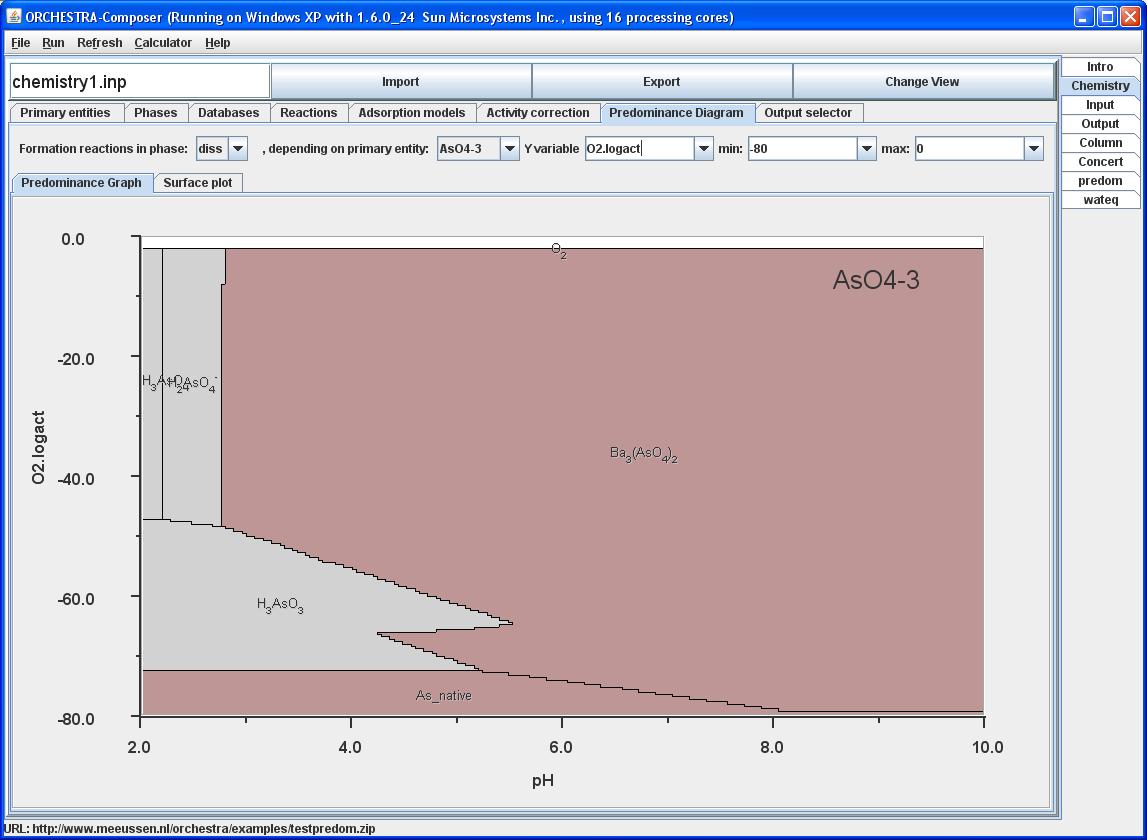Introduction
The ORCHESTRA examples presented here can be run directly within a Java-enabled web-browser.
If your browser doesn't support Java, download Java from Sun Microsystems here:
Latest changes: 1 June 2011, Hans Meeussen
Introduction
The ORCHESTRA examples presented here can be run directly within a Java-enabled web-browser.
If your browser doesn't support Java, download Java from Sun Microsystems here:
Run on-line
The run button with each example starts the ORCHESTRA COMPOSER with the example input file. Within the COMPOSER you can browse through the input and output files, make changes and re-run the examples with new settings by clicking the RUN button.
Download an run off-line
The complete ORCHESTRA program, (orchestra2.jar 300 Kb) can also be downloaded and used off-line in combination with the separate input files
After downloading, ORCHESTRA can be started from the(windows/linux/macosx) command line with:
java -cp orchestra2.jar orchestra2.composer
The ORCHESTRA input files are zipped folders that contain all necessary files for an input system. They can be used by ORCHESTRA directly or in unzipped form.
Database files
ORCHESTRA uses a number of database files as input. The example files given here use the web versions of these files, but they can be downloaded to avoid dependency on an internet connection.
The model object datas contains the defintion of all chemical and physical the model objects and is used during the calculations.
Object Database
The model object datbase contains definitions of all chemical and physical model objects and is used during the calculations.
Aqueous complexation and mineral precipititation reactions
A file with chemical reactions and species that is used by the chemistry editor.
This file was created by converting the standard MINTEQ V4.0 database file to ORCHESTRA format.
Additions by ECN
A file with extra reactions patches and extensions to the standard MINTEQ V4.0 file, created by ECN.
Adsorption reactions
A file with adsorption reactions the following surface complexation models; Nica-Donnan, DDL model for hfo with paramaters by Dzombak and Morel, Same model with paramers for manganes oxide by Tonkin, CD-Music model for goethite, Basic Stern Model for SiO
Speciation of Carbonate as a function of pH
This first example is a kind of “Hello World” speciation example. It just calculates the chemical speciation of a proton carbonate system distribution and in this case the distribution of carbonate over the different protonated forms as a function of pH. Have a look at the input and output files. Change the total carbonate concentration in the input file and see if you can re-run the system with a different total carbonate concentration. Check in the output file that the total amount has indeed changed. To make graphs, just copy the contents of the output file to a spreadsheet.
Run on line:
Download: input file(example1.zip ca. 7 kb)
Creating predominance diagrams on-line
This is an example of how to create an ORCHESTRA predominance diagram on line. It is set up identical to the example of David Kinniburgh's Phreeplot (www.phreeplot.org) with the full wateq4f thermodynamic database and all total component concentrations at 0.01 M. To run the example: click on the button below, go to the chemistry tab, and in there to the predominance diagram tab. The calculations start after selecting a primary entity (component).
Run on line:
Download: input file(testpredom.zip ca. 17 kb)
Here is an example graph for As:

Running the example off-line will produces .jpg files of thegraphs in your local folder.
Speciation of Carbonate as a function of total Carbonate concentration
This example calculates the distribution of carbonate and calcium over different species a a function of total H2CO3 concentration. The start situation is an amount of Portlandite in water (0.1 M) which creates a pH of ca. 14. This solution is titrated with CO2, which causes dissolution of Portlandite and precipitation of Calcite. Note that when Calcite and Portlandite are both present the pH stays 12.5 for a while . Once Portlandite has dissolved completely the pH gradually drops to acidic values. The variable CO2[g].act in the output shows the partial CO2 pressure. Note that in comparison with example 1, in this example H2CO3 is chosen as a component in stead of CO3-2. This is just to make it easier to titrate with H2CO3. It would also be possible to titrate with CO3-2 and H+ at the same time.
Run on line:
Download: input file(example2.zip ca. 7 kb)
Redox example
This example shows how to simulate oxidation of iron (Fe+2) by oxygen. An amount of Fe(OH)2 is titrated with oxygen, and the resulting iron speciation and pH and redox changes are calculated.
Run on line:
Download: input file(example4.zip ca. 7 kb)
Nica-Donnan adsorption example
This example shows how to include adsorption in the speciation calculations. It is set up to calculate adsorption of copper Cu+2, on colloidal humic acid according to the Nica Donnan model. In the input file, the concentrations of humic acid, and background electrolyte can be given. After running, the results will be visible in the output file.
Run on line:
Download: input file(example4.zip ca. 7 kb)
Nica-Donnan adsorption example (Cu+2 and Zn+2)
This example shows how to include adsorption in the speciation calculations. It is set up to calculate adsorption of copper Cu+2 and Zn+2 on colloidal humic acid according to the Nica Donnan model. In the input file, the concentrations of humic acid, and background electrolyte can be given. After running, the results will be visible in the output file.
Run on line:
Download: input file(example5.zip ca. 7 kb)